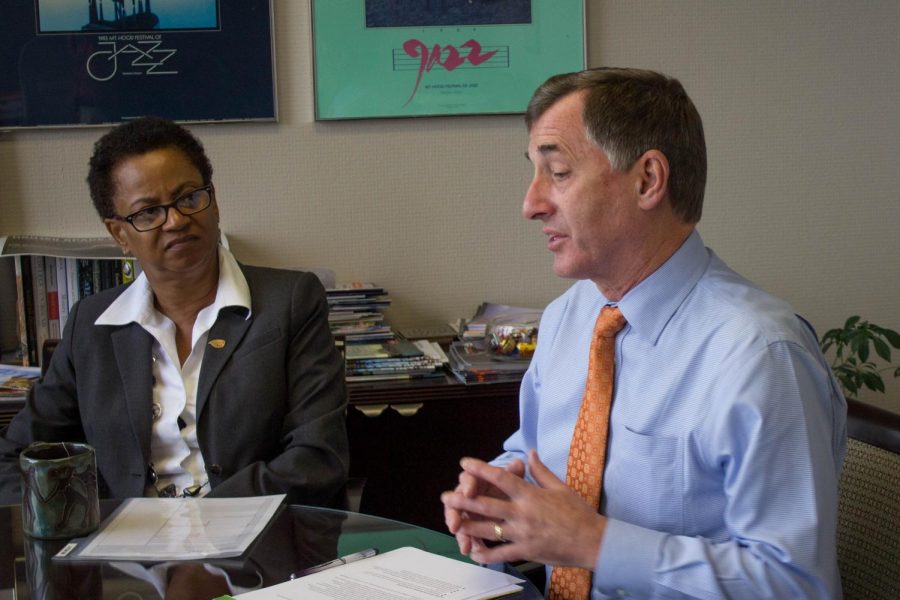We Have Work to Do campaign seeks to ‘articulate OSU’s values’
November 5, 2018
In 2017, there were only 7,660 students of color out of the 25,838 undergraduate students attending Oregon State University. In an effort to promote diversity at OSU, the Office of Institutional Diversity was created in 2015, along with a newfound campaign for the 2018-19 school year: We Have Work To Do.
“The Office of Institutional Diversity was created to provide a greater focus to diversity initiatives throughout the university,” Vice President and Chief Diversity Officer in the Office of Institutional Diversity Charlene Alexander said. “The We Have Work To Do campaign was designed to proactively articulate OSU’s values and help set the tone for the climate of the university for this year.”
Director of Strategic Initiatives in the Office of Institutional Diversity, Scott Vignos, also stated the purpose of the campaign along with its importance to the OSU community.
“We Have Work To Do was created to acknowledge and recognize that while we have made great strides at Oregon State to build a culture of inclusion and to ensure that students and faculty from underrepresented backgrounds can be successful, we also have a long way to go to realize a truly inclusive university,” Vignos said.
According to the We Have Work To Do website, the campaign has five themes: building equitable learning environments, establishing a sense of belonging, creating coalitions, transforming our future and confronting bias.
“Aside from the stated themes, one of the campaign’s main goals is to orient Oregon State community members to the idea that we all have an integral role to play in creating equity and inclusion at OSU,” Vignos said. “This work does not live in a single office or program, but rests with all of us to take action in our own spheres of influence.”
Vignos stated that other organizations leading efforts toward a more inclusive university include Diversity and Cultural Engagement, the Division of Student Affairs and the Division of Faculty Affairs.
The campaign is also closely tied to OSU’s first comprehensive diversity strategic plan, which was also launched in 2018, called Innovate & Integrate: Plan for Inclusive Excellence. The plan was developed in coordination with a Strategic Plan Committee, which included a diverse range of university students, faculty and staff. Vignos stated that this plan includes some of the concrete actions OSU is taking to improve items like education and recruitment in the areas of diversity, equity and inclusion.
One member of the Strategic Plan Committee involved in developing the goals of the plan was Sastry G. Pantula. Pantula is the former dean of the College of Science, is currently the Dean of Natural Sciences at CSU-San Bernardino.
“My role in the committee was to brainstorm with other committee members and bring my experience and commitment to my core values to the table,” Pantula said. “[The committee] met several times, including a day-long brainstorming session with an external facilitator. We did several group activities to brainstorm ideas and prioritize the list to develop a draft of strategic goals.”
According to the Office of Institutional Diversity website, Innovate & Integrate is organized around five key goals. They include integrating and advancing excellence within all aspects of the university. From improving the recruitment of students and employees from underrepresented communities, to creating an inclusive university climate supporting the success of all students and employees. The office aims to provide innovative and transformative learning experiences to advance inclusive excellence, as well as demonstrating OSU’s accomplishments, initiatives and innovations.
The Office of Institutional Diversity website acknowledges that “these goals are ambitious, but attainable.”
“OSU has a long way to go in enhancing diversity,” Pantula said. “Recruiting diverse faculty, staff and students is one big step. Having a culture that makes everyone feel welcome and included is a much bigger step. Retention gets harder without an inclusive excellence culture.”
Although the campaign We Have Work To Do is scheduled for the 2018-19 school year, Vignos hopes to see its themes and goals implemented for years to come.
“The whole point of the campaign is to recognize that making progress requires consistent, creative and iterative efforts,” Vignos said. “So, even if the campaign ends, the work itself will go on.”
























































































































